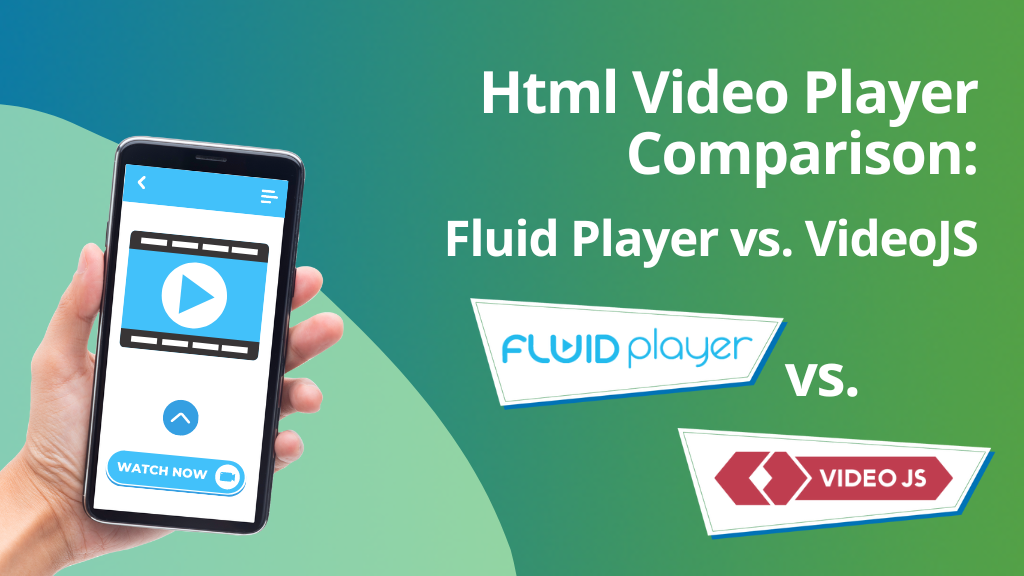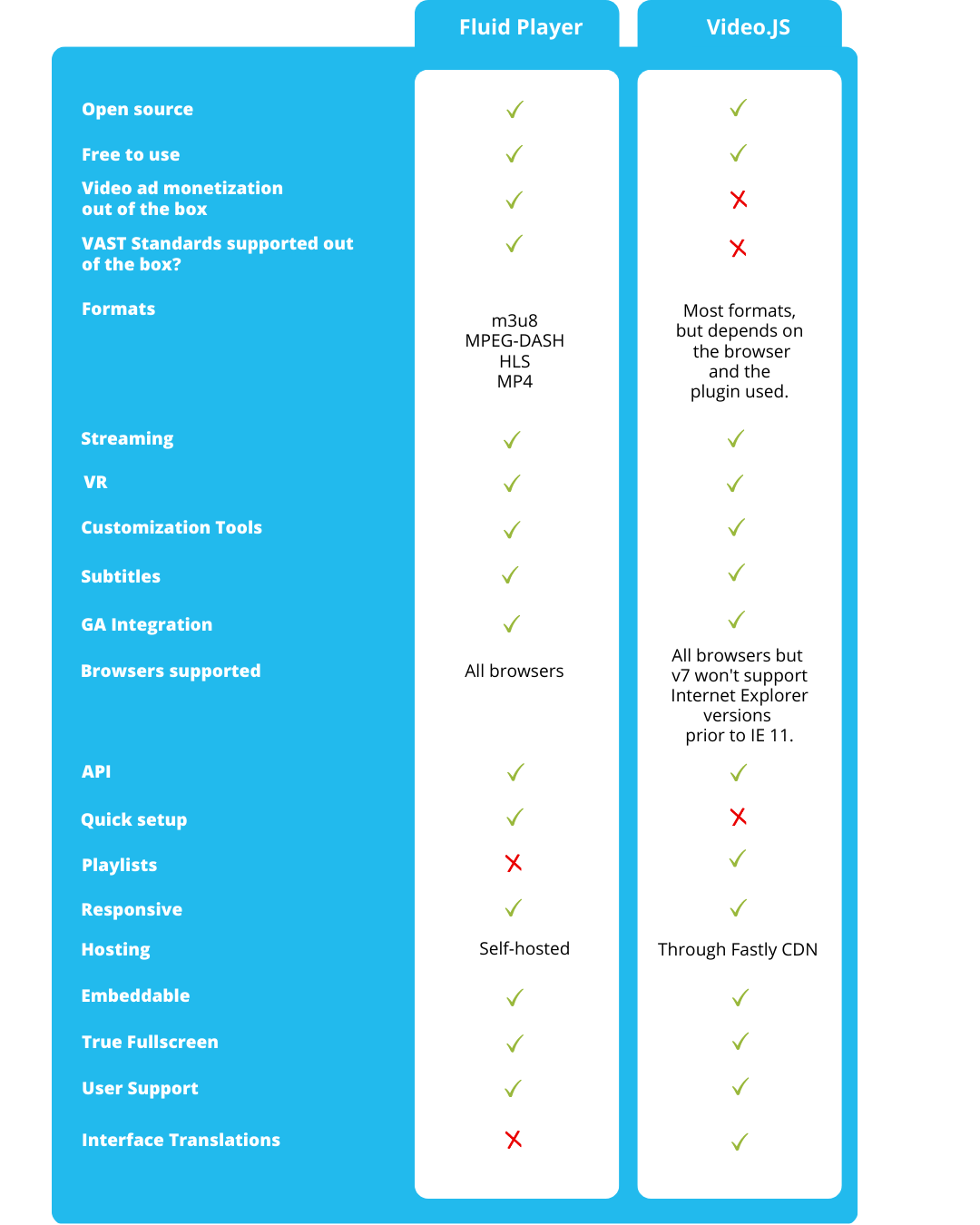Free HTML video players compared: Fluid Player vs. Video.JS

With 91% of online businesses using video as a marketing tool, online video content has become a fundamental part of digital advertising. Are you a publisher looking to stream and monetize video content on your site? Welcome to the second edition of our video player comparison series! In our fist article we measured Fluid Player against JW Player. On this occasion we are going to compare Fluid Player to Video.JS, both popular HTML5 open source video players, completely free of use. To help you choose which video player is best for you, we have compared their key features in the table below:

As you can see, both players support Streaming and VR formats, are fully responsive, and allow subtitles, amongst other features. However, there are some key differences. Video.JS is infinitely more customizable than most players in the market, however the customization process can be relatively complex. Fluid Player has less customization options, however it comes with great default settings that can get you effortlessly sharing and monetizing video content from day 1 - Continue reading for more details!
Fluid Player: The lightweight free open source HTML5 player
Fluid Player is easy to integrate, has got out of the box video monetization tools, allows more than 1 player per page, and features lots of keyboard shortcuts that are also customizable. You can find the downloadable files on GitHub, through self-hosted CDN for an easy setup. It has advanced VAST and VPAID capabilities and it comes with its own design, which is easily and quickly customizable to your site’s style. The formats supported are m3u8, MPEG-DASH, HLS, MP4, and VR.
A player for everyone, ready to use from minute 1!
Fluid Player can be used on your site straight away after a quick setup, without any extra customization, so that you can start streaming and monetizing video content asap without bothering with huge amounts of code or spending time adding extra plugins - It already looks great out of the box!
Or maybe you want to tailor it to fit your brand’s needs, which you can easily do using optional parameters to change the player’s style. For instance, you can change the color of the player’s buttons, the progress bar, add a poster image before the video plays, change where the play button will show on the player, enable or disable a play / pause animation, enable or disable autoplay, play around with the keyboard controls, set a timeline preview, and many more. Want to see how easy it is to customize the player and its functionalities? Learn how to use The Builder here!
Out of the box VAST and VPAID standards advanced capabilities
VAST (Video Ad Serving Template) specification is a universal XML schema defined and released by the Interactive Advertising Bureau (IAB) that sets a standard for communication requirements between ad servers and video players - Basically, it makes it possible for an ad provider to serve ads to various video players using the same universal language. Bear in mind that not all players do support VAST, yet this standard is crucial to monetize video content on your site.
Fluid Player supports VAST out of the box, which you can benefit from straight away and effortlessly. Some of Fluid Player’s VAST capabilities are:
- Multiple VAST tags (pre-roll, mid-roll, post-roll)
- Linear (video) ads
- Non linear VAST tags (banner images (gif/jpg/png))
- VAST Wrappers
- VPAID Ads (Linear, Nonlinear, switch over from Nonlinear to Linear)
Start monetizing your video content NOW!
Fluid Player’s video monetization features are also enabled by default, and can be integrated with any ad network, ad exchange or video ad server. Here are some of the ad tools that come with the player:
- Pre, mid and post-roll in-stream video ads
- Custom HTML banner when the video is on pause, ad text message in the top right corner of the video screen
- VAST non-linear banner in-video ad overlay with image insertion (gif/jpeg/png) during video playback
So if you want to monetize your site’s traffic in order to generate extra revenues, you can get started the very minute you have finished setting up the player - Of course, these can also be customized.
Github and Documentation
If you have any questions or issues with your player, you can raise tickets through GitHub, where a member of our Client Care team will look to sort out any issues you may have asap. Also, you have any information that you might need about setup and features at your disposal through Fluid Player's documentation.
Video.JS: A community maintained and flexible video player
Video.js is a popular video player maintained by an extense community of developers. It supports HTML5 video and modern streaming formats, as well as YouTube and Vimeo. It comes with lots of styling choices, and the interface can be translated to hundreds of different languages to make its handling easier for you, whatever your native language is.
If you need to add additional functionalities, there are over 100 plugins available to you. The community has already built hundreds of skins and plugins that you can install, such as Chromecast, IMA, and VR - In short, Video.JS offers a world of opportunities, however it all comes down to the add-ons that you decide to install, or even build yourself!
A world of plugins opening up to you
Video.Js is built upon a solid and reliable default, on top of which you can use as many skins and plugins as you want, in order to make it work exactly as you want. This makes this player incredibly flexible and versatile - You can make it do virtually anything that you need or support almost any media format, however, you will need to take some time to understand which plugins you require, and then install them and set them up. For instance, whether the format that you are using works on Video.JS or not depends on the formats supported by the browser's HTML5 video element, and the playback techs/plugins that you install.
You also have plugins to build and display playlists, to display simple overlays during video playback, for custom error reporting, and to implement video monetization, amongst many others. Here are 4 examples of plugins:
- Videojs-contrib-quality-levels exposes a list of quality levels available for the source
- Videojs-playlist is one of the playlist plugins for Video.JS
- Videojs-contextmenu-ui enables a cross-device context menu UI for Video.js players
- Videojs-overlay allows display simple overlays during video playback
Video monetization support and communication protocols
If you are thinking of implementing video ad monetization on your site using Video.JS you will need a basic plugin (videojs-contrib-ads), which will add core advertising support to your player. You will also need the VAST and VPAID standards add-ons, which as we have said beforehand, are key to display paid ad content on your site as they enable the communication between your ad provider and your video player. With these basic plugins you can start setting up video ads on your site, and then you can then use further plugins on top, like for instance Google's IMA plugin.
User Support: A Community of Developers to your service!
As mentioned above, one of the great advantages of Video.JS is that you can build your own extensions in order to completely tailor the player to your needs - It is a project in constant development, and the minute that you start using this tool and contributing to its features’ expansion, you become part of a larger community of developers. If you find any issues whilst using the player or need any support, you can either use their troubleshooting guide or read their Documentation, submit an issue in Github, or ask in their Slack community. However, there is no direct Client Care support line.
Conclusion: Fluid Player, a Video.JS alternative?
When deciding whether to use Fluid Player of Video.JS, you need to have very clear in your mind your own needs as a publisher, as well as how much time and effort you can spare to set up and manage your video content on a daily basis. On the one hand, Video.JS is one of the most adaptable players out there, however you need to be up to experiment with plugins, coding, and be open to constant troubleshooting. On the other hand, Fluid Player is pretty much ready for you to use with its’ basic settings, and has a more reduced number of feature personalization options available, making it a great Video.Js alternative if you are managing an online business and don’t have any extra time to devote to styling and maintaining your player.